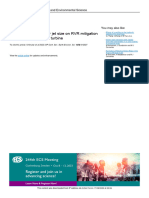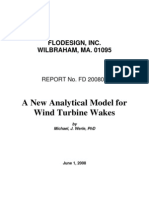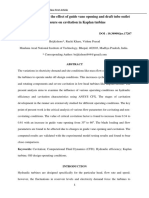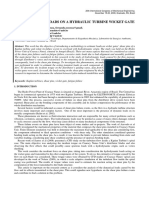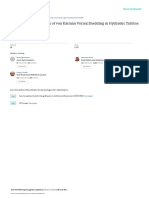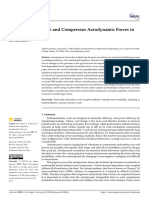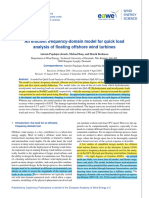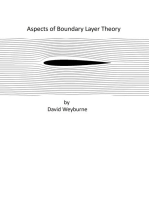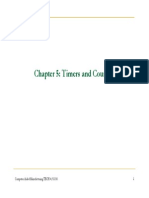CFD 1 PDF
CFD 1 PDF
Uploaded by
Google DocsCopyright:
Available Formats
CFD 1 PDF
CFD 1 PDF
Uploaded by
Google DocsOriginal Description:
Original Title
Copyright
Available Formats
Share this document
Did you find this document useful?
Is this content inappropriate?
Copyright:
Available Formats
CFD 1 PDF
CFD 1 PDF
Uploaded by
Google DocsCopyright:
Available Formats
Scientific Bulletin of the Politehnica University of Timisoara Transactions on Mechanics Tom 52(66), Fascicola 6, 2007
2nd IAHR International Meeting of the Workgroup on Cavitation and Dynamic Problems in Hydraulic Machinery and Systems Timisoara, Romania October 24 - 26, 2007
RECENT DEVELOPMENTS IN THE DYNAMIC ANALYSIS OF WATER TURBINES
Helmut KECK *
VA TECH HYDRO Switzerland
Wolfgang MICHLER
VA TECH HYDRO Switzerland
Thomas WEISS
VA TECH HYDRO Switzerland
Mirjam SICK
VA TECH HYDRO Switzerland
*Corresponding author: Hardstrasse 319/P.O. Box, CH-8023 Zurich, Switzerland E-mail: Helmut.Keck@vatech-hydro.ch ABSTRACT This paper gives an overview of current methods for life cycle analysis with special emphasis on dynamic load analysis. Recent developments in CFD simulations of time dependent phenomena are presented, such as the von Krmn vortex shedding at stay vanes in a Kaplan turbine and the part load vortex in the draft tube of a Francis turbine and a pump turbine. A major topic of this paper is the unsteady pressure field in a pump turbine which is caused by the interaction of guide vanes and runner blades. CFD results of the pressure pulsations and their validation through comparison with measurement data are presented. It is shown how the predicted time dependent pressure load is transferred as input to the structural analysis of the runner. For the analysis of the response of the runner to the dynamic load knowledge of the natural frequencies of the structure is required including the influence of the surrounding water on the natural frequencies. New results of the prediction of the natural frequencies of a Francis runner including the added mass effect due to the surrounding water are presented. For Pelton runners the state-of-the art of measurement of eigenfrequencies and detuning are discussed along with the potential improvements due to the new simulation methods. 1. INTRODUCTION During the last few years dynamic load analysis of the components of hydraulic turbines has become a major issue. There are three main reasons for this. Firstly, customers request more efficient and, at the same time, less expensive machines, which are usually less robust. Secondly, refurbishment projects are often targeted at a considerable increase in flow rate and power output which means higher load on the machine components. Thirdly, hydro power plants are operated in a more challenging way; a wider operating range is needed and there are more load changes with more frequent starts and stops in order to respond to the increased need for peak shaving, balancing energy and spinning reserve. As a consequence, new technologies are needed, especially for the design and manufacturing of large runners, see Keck et al. (2002). Empirical rules and calculation methods of safety engineering, which have been perfectly adequate for conventional designs for decades, might no longer be valid for more modern machine designs, a fact which in some cases lead to severe problems or even failure of components, see Coutu et al (2004). In order to improve reliability of these conventional methods, both measurement techniques and calculation methods are continuously being refined and further developed. Further developments are taking place in all engineering disciplines in the water turbine design: Measurement techniques: improvement and application to increasingly complex systems, e.g. PIV measurement of draft tube vortex, measurement of natural frequencies of Francis runner in water. Structural analysis: refinement to more design details and extension to more realistic boundary conditions e.g. the influence of surrounding water. CFD analysis: extension to time dependent flow phenomenon such as von Krmn vortices or the interaction between wicket gate and runner. Most recent examples for the development and application of the new engineering methods are presented for all types of turbines. Kaplan turbine: von Krmn vortex shedding at the stay vanes, with focus on the application of refined CFD
10
Proceedings of the 2nd IAHR International Meeting of the Workgroup on Cavitation and Dynamic Problems in Hydraulic Machinery and Systems
Francis turbine: draft tube vortex, with focus on application of new measurement techniques and CFD Francis turbine and pump turbine: interaction between wicket gate and runner, with focus on structural analysis of natural frequencies, CFD analysis of the time dependent flow and harmonic response method Pelton turbine: jet bucket interaction, with focus on excitation and detuning of the runner The paper is mainly based on the following publications: Sick et al., Parkinson et al., 2007, Schmied et al., 2006. 2. KAPLAN TURBINE: VON KRMN VORTEX SHEDDING AT STAY VANE EXIT In 2006 Lockey and Keller published the results of an unsteady CFD simulation of von Krmn vortex shedding at the stay vanes of a Canadian hydro power station. It was the first time that CFD had been applied to explain in detail the origin of stay vane failure and to evaluate proposed refurbishment alternatives. Before applying CFD to the complex case of an existing hydro power station Keller validated the CFD method for a NACA009 profile by comparing the CFD prediction to measurements of the HydroDyna project (Ausoni et al. 2006). The main
findings of the validation study are firstly the grid dependency of the solution and secondly the dependency on the turbulence model. In a most recent study Nennemann et al. found that the shedding frequency is slightly shifted when the transition from laminar to turbulent boundary layer is taken into account leading to an improved accuracy of the prediction. This finding is confirmed by experiments with varying surface roughness at the blade inlet. As it is well known that the shape of the trailing edge strongly influences the intensity of the vortex shedding a major focus of the validation study was the effect of different trailing edge geometries. It could be shown that indeed the trailing edge geometry determines the interaction of the counter rotating vortices. A dovetail modification leads to a partial elimination of the vortices by forcing the vortices to move a bit upstream into the centre of the dovetail. The Donaldson modification has a similar effect by shifting one of the two separation points of the boundary layer causing a partial elimination of the vortices, see Figure 1. The tendency of the amplitudes as predicted by CFD is in agreement with published experimental data. However, more detailed validation has to be done by directly comparing CFD prediction with experimental data.
Blunt trailing edge Amplitude: 100% Frequency: 100%
Dove tail trailing edge Amplitude: 84% Frequency: 96%
Donaldson trailing edge Amplitude: 32% Frequency: 99%
Figure 1. Influence of the trailing edge geometry on the force acting on the blade as predicted by CFD
Dovetail modification of the stay vane trailing edge
Donaldson modification of the stay vane trailing edge
Figure 2. CFD simulation of the vortex shedding at the trailing edge of the stay vanes in a hydropower plant for two different guide vane openings and two different trailing edge geometries. Part load (left) and optimum load (right)
Proceedings of the 2nd IAHR International Meeting of the Workgroup on Cavitation and Dynamic Problems in Hydraulic Machinery and Systems
11
In a hydropower plant the vortex shedding interacts with other components as illustrated in Figure 2 which shows the vortex street forming at the stay vane trailing edge and being entrained along the surface of the subsequent guide vane. Highly complex time dependent flow patterns may arise from this interaction. Discussion 1. Flow mechanisms: Applying CFD for the analysis of von Krmn vortex shedding at stay vanes in hydropower stations gives considerable insight into the mechanisms which influence both frequency and amplitude of the pressure oscillations acting on the structure. CFD simulations provide information about the wake thickness which is relevant for the frequency of the vortex shedding as well as the position of the separation points which partly determines the amplitude of the pressure oscillation. 2. Frequency and amplitude of pressure pulsations: Several comparisons with experiments have been done which show a good accuracy of the predicted frequency. Especially for the case that the blade thickness of the stay vanes vary with the circumferential position a CFD simulation provides valuable information about the von Krmn excitation frequencies. With respect to the amplitudes of the pressure pulsations some good results have been obtained but more validation work has to be done. 3. Structural response: A structural analysis of the natural frequencies has been carried out in several cases in order to identify which of the frequencies might be in resonance with the von Krmn excitation. In fact, if a natural frequency of the structure coincides with the excitation frequency of the vortex shedding a reduction of the excitation amplitude by trailing edge modification might not be sufficient. Grein and Staehle give the example of a 184 MW Francis turbine for which stay vane failure could not be eliminated by modifying the trailing edge geometry only. It was necessary to modify the design of the stay vanes such that the natural frequencies of the structure were shifted. A similar case is reported by Lockey et al., 2006.
Today it is possible to numerically predict the complex time dependent flow patterns of von Krmn vortex shedding in the stator of a water turbine. The CFD results are sufficiently accurate such that practical problems can be solved. Still, there are some open questions: the prediction of the effect of boundary layer transition on the vortex shedding frequency has to be further validated, the accuracy of the prediction of the separation points of the boundary layer has to be investigated especially for the round trailing edge geometry and some more thorough validation of the prediction of the amplitude of the pressure oscillations will be needed. It is planned to do more of this validation work in the course of the HydroDyna project at IMHL, EPFL, Switzerland (http://hpc.epfl.ch/bgl/ scientific-projects/hydrodyna/hydrodyna-project). 3. FRANCIS TURBINE AND PUMP TURBINE 3.1. Draft tube vortex flow First attempts to predict the complex unsteady flow structure of a draft tube vortex have been undertaken about eight years ago and it became very quickly evident that for this flow which is determined by vortex dynamics at both small and large scales the turbulence model is of crucial importance for the accuracy of the CFD results. A detailed validation of the CFD results in comparison to measurements was published in 2002 by Sick et al. As at part load nonsymmetrical flow patterns become increasingly dominant the interaction between runner and draft tube significantly influences the turbine flow. Consequently, both the grid resolution and the modelling of the interface between runner and draft tube have to be done with great care as demonstrated by Stein et al. in 2006. The grid resolution in the runner determines the accuracy of the prediction of the interblade vortices and thereby the accuracy of the prediction of velocity profile at draft tube inlet and the vortex rope frequency. Results of the numerical simulation of the FLINDT draft tube at part load operation are shown in Figure 3. Vortex rotation frequency f Experiment: f/n = 0.302 Coarse grid: f/n = 0.236 Fine grid: f/n = 0.290
CFD coarse grid
CFD fine grid
Model test flow mechanisms is a prerequisite for design engineers to optimise the hydraulic design of a turbine with respect to draft tube vortex flow. Furthermore, CFD simulations can deliver information about fre-
Figure 3. Grid dependency of the CFD solution: Inter blade vortex and rotational speed of the vortex rope. Discussion Numerical flow simulations of the draft tube vortex flow can be targeted to answer questions about the flow mechanisms. A good understanding of the
12
Proceedings of the 2nd IAHR International Meeting of the Workgroup on Cavitation and Dynamic Problems in Hydraulic Machinery and Systems
quency and amplitude of pressure pulsations in the prototype, and the effect of cavitation on the pressure pulsations which enable the effect of the draft tube vortex on the structure to be predicted. Figure 4 shows
800 600 400
the lateral forces and bending moments acting on the shaft of a pump turbine which are caused by the draft tube vortex. The agreement between numerical prediction and experimental data is found to be very good.
600 400
200
200 0 0.0 -200 -400 2.0 4.0 6.0 8.0 10.0
0 0.0 -200 2.0 4.0
f 6.0 8.0 10.0
-400
-600 -800 Number of revolutions
-600
Number of revolutions
Lateral Force Fx
80 60 40 20 0 -20 -40 -60 -80 -100 Number of revolutions 0.0 2.0 4.0 6.0 8.0 10.0
Lateral Force Fy
100 80 60 40 20 0 -20 -40 -60 -80 Number of revolutions 0.0 2.0 4.0 6.0 8.0 10.0
Bending Moment Mx
Bending Moment My
Figure 4. Lateral forces and bending moments on the shaft due to the draft tube vortex: comparison measurement data (grey) and CFD prediction (black) 1. Measurement technique: Considerable progress has been achieved with respect to experimental insight into the velocity field of the draft tube vortex (Ciocan et al., 2004) by applying LDA and PIV measurements to this complex, time dependent flow phenomenon in addition to pressure measurements. 2. Flow mechanism: CFD simulations show in detail the swirl distribution and the backflow zone with the resulting rotating shear layer and vortex production in the centre of the draft tube cone. Validation of the CFD results versus measurements of the velocity field in the draft tube cone show good agreement thus justifying confidence in the CFD results. The improved insight into the flow mechanisms has given rise to attempts to directly influence the pressure pulsations caused by the draft tube vortex. 3. Frequency and amplitude of pressure pulsations: For both model and prototype the CFD simulation gives the quantity of the pressure pulsations. Most notably, the synchronous and the asynchronous part of the pressure excitation can be identified. 4. Effect of cavitation: As cavitation zones introduce compressibility into the hydraulic system they strongly alter the dynamic behaviour of both the vortex rope and the hydraulic system. First results of CFD predictions including cavitation were published by Stein et al. in 2006 showing strong grid dependency of the results and an unsatisfying accuracy. 5. Structural response: Forces and moments as consequence of the pressure pulsations result directly from a CFD simulation. They have been successfully validated for the shaft of a pump turbine runner (Sick et al, 2004). Ruprecht et al. made a first attempt to model the whole system and its excitation by the vortex rope in 2002 but since then there has been no further development of models for the response of the system.
Proceedings of the 2nd IAHR International Meeting of the Workgroup on Cavitation and Dynamic Problems in Hydraulic Machinery and Systems
13
During the past few years CFD methods for the prediction of the draft tube vortex flow have been developed and applied with great success. Still, there are open questions with regard to the accuracy when cavitation is taken into account and with regard to the response of the entire hydraulic system. While the questions with respect to accuracy of the CFD simulation might be tackled with relatively reasonable effort in the near future modelling the hydraulic system response will be a far more challenging task. 3.2. Rotor Stator Interaction In turbo machines the interaction between the rotating pressure field caused by the runner with the wakes produced in the wicket gate is the omnipresent source of dynamic load on the components. All engineering disciplines measurement, flow analysis and structural analysis have to be applied hand in hand in order to analyse the dynamic load and the resulting stress and residual life. Dynamic load assessment in water turbines is conventionally based on the proportional approach in which the dynamic pressure load is assumed to be a fraction of the static pressure, see for example Seidel et al (2006). This approach is still good for many applications but not always sufficient. The harmonic response method is far more realistic because it is based on the predicted or measured time dependent pressure field caused
by the unsteady flow and on the knowledge of the natural frequencies of the structure which again have to be either calculated or measured. The latter approach was adopted by Coutu et al. (2004) for the analysis of stress in the St. Marguerite Francis runner in order to prove that the suggested geometry modification would no more lead to cracks. Since then further progress has been made especially with respect to the analysis of natural frequencies under the influence of water, see Lais (2007). CFD simulation of the rotor stator interaction Because of relatively high blade loading, high rotating speed and thick guide vanes and small gaps the interaction between guide vanes and rotor blades is the main source of vibrations in high head pump turbines. For this reason a pump turbine has been chosen for the first steps towards CFD analysis of rotor-stator interaction (RSI). At the same time there are mechanical conditions in the prototype differing from test rig which makes prototype measurements necessary as reported by Egusquiza et al., 2006. Thus, the main objective of current research is the combination of reliable CFD predictions of the pressure oscillations due to RSI with a realistic numerical analysis of the mechanical properties of the prototype such that the response of the structure to the dynamic load can be predicted during the early design phase of a turbine runner.
Instantaneous static pressure field
Static pressure on the band between two guide vanes
Figure 5. CFD simulation of the pressure field in a pump turbine (left); comparison CFD prediction - measurement (right) A CFD method has been set up and validated by Keller et al. (2006) for the numerical simulation of the dynamic load on a pump turbine runner which is due to the interaction of guide vanes and runner blades. The prediction of the major excitation frequencies is correct as can be seen in Figure 5 on the right hand side. As the frequency of the pressure oscillation is prescribed by the number of guide vanes and runner blades on one hand and the rotational speed on the other hand the signal is mainly a superposition of
14
Proceedings of the 2nd IAHR International Meeting of the Workgroup on Cavitation and Dynamic Problems in Hydraulic Machinery and Systems
a constant part and three distinct frequencies, the harmonics of the runner blade passing frequency (i.e. rotation frequency times number of runner blades). More remarkable is the fact that the amplitudes of the pressure oscillations are found to be predicted with very good accuracy.
With a time dependent CFD simulation of spiral casing, entire stator and entire rotor it is possible to detect the node shapes of the exciting modes. This was demonstrated by comparing the CFD prediction of the pressure oscillations for two different pump turbine runners one with 7 blades, the other with 9 blades coupled to a 20 guide vanes stator (Keller et al., 2006).
Runner with 7 blades: Phase angle at 3rd Harmonic
Runner with 9 blades: Phase angle at 2nd Harmonic
Figure 6 Decomposition of the predicted pressure field shows the shape of the excitation mode: 1 node (left), 2 nodes (right) According to Tanaka (090) the interaction of stator and rotor leads to pressure waves at rotating pressure modes which depend on the number of stator channels (zS) and number of runner blades (zR): k = M z R N z S . While mode 0 represents a standing wave on the rotating runner system the other modes are rotating with speed nM ( nM = n zS ). Pressure
k
modes with negative node number k are counter rotating, those with positive node number are rotating with the runner. As shown in Figure 6 the CFD simulation exactly reveals the pressure modes as expected based on the literature. Thus, if the natural frequencies are known from structural analysis the CFD simulation allows critical excitation modes to be identified and further analysed with respect to their effect on the structure. Furthermore, the CFD simulation accurately predicts the direction of the pressure wave propagation which is of considerable significance for the vibration behaviour of the whole machine: pressure waves propagating against the runner rotation into the spiral casing and further upstream can cause undesirable vibrations in the penstock. 3.3. Numerical prediction of natural frequencies A high head Francis turbine runner has been selected in order to validate the numerical analysis of natural frequencies, see Lais (2007). For the simulation of the runner properties in water the computa-
tional grid includes not only the runner but also a surrounding volume representing the water, see Figure 8, left. Please note that the constellation under discussion refers to the situation at the test rig but not to the runner as it is installed in the plant. Under the influence of water the shape of the mode is found to stay the same see Figure 8, middle and right hand side. But the surrounding water strongly influences the value of the natural frequencies reducing them by a factor between 0.4 and 0.9 depending on the mode. Figure 8 gives the detailed results of the numerical prediction on one hand and the measurements of the mode shapes of the Francis runner under consideration on the other hand. Firstly, it can be seen from this diagram that the numerical prediction and measurement agree very well but also, that some more measurement points are needed for a complete validation of the numerical methods. Secondly, the frequency reduction due to the damping effect of the surrounding water is shown to strongly differ for the different modes. For design engineers this information is extremely important because it will allow a leaner design of the turbines with more targeted safety margins. Discussion 1. Flow mechanisms: A time dependent CFD simulation of the runner together with the stationary components reveals the major mechanisms of the rotor stator interaction which take place at the basic frequency (pressure pulsations at rotational speed
Proceedings of the 2nd IAHR International Meeting of the Workgroup on Cavitation and Dynamic Problems in Hydraulic Machinery and Systems
15
Computational grid: runner with surrounding volume
ND2-1 mode: FE prediction of displacement in air
2000 1800
ND2-1 mode: FE prediction of displacement in water
1.0 0.9 0.8 0.7 0.6 0.5 0.4 0.3 0.2 0.1 0.0
Figure 7 FE analysis of Eigenmodes of a high head Francis turbine runner
Frequency Reduction Factor =fw/fa
Measurement Natural Frequency in Air Measurement Natural Frequency in Water Prediction Natural Frequency in Air Prediction Natural Frequency in Wate Prediction Frequency Reduction Factor fw/fa
Natural Frequency [Hz]
1600 1400 1200 1000 800 600 400 200 0
8 1 2 3 4 5 6 7 9
Nodal Diameter Mode ND [-]
Figure 8 Modal analysis of a Francis runner in air and in water: comparison numerical prediction measurement times number of the blades) and its harmonics. As major effects the flow deviation in the wake of the guide vanes on one hand and the upstream effect of the leading edge of the runner blades on the other hand are identified by CFD with very good accuracy. 2. Frequency and amplitude of pressure pulsations: Frequency, mode and amplitude of the pressure oscillation are found to be very well represented by CFD when certain standards of grid density, discretisation scheme (2nd order accurate), time step, computational domain and boundary conditions are fulfilled. 3. Structural response: With the information about the flow and the related pressure field gained by a transient CFD simulation it is now possible to calculate the resulting stress at each point of the runner
10
11
12
13
14
15
16
17
18
20
19
21
22
16
Proceedings of the 2nd IAHR International Meeting of the Workgroup on Cavitation and Dynamic Problems in Hydraulic Machinery and Systems
at each time step. As such a procedure would be extremely expensive in terms of computing time and memory a leaner approach is chosen: the analysis of the structural response at selected frequencies. Based on the developments and the validation study presented in this paper it is now possible to numerically predict the natural frequencies of a rotor both in air and in water with very good accuracy. For design engineers this is a significant step forward towards safety engineering with more targeted safety margins and design rules. Predicting the natural frequencies of the prototype allows more knowledgeable decisions to be made during the design phase and less correction such as detuning to be done during the manufacturing phase which is beneficial to both turbine manufacturers and power plant operators. During the last two years significant progress has been made in predicting the effect of rotor stator interaction in a pump turbine both on the flow field and on the structure. Still, some more validation work has to be done for pump turbines in pump mode and for other turbine types. Limitations of the CFD simulations presented are due to the fact that constant mass flow and the flow direction are imposed at inlet while at outlet the static pressure is set to an average value. With this approach potential temporal and spatial fluctuations in mass flow rate are not taken into account. Furthermore the fluid is assumed to be incompressible which means that wave speed is infinite. This assumption will have to be questioned in further research. Also with respect to structural analysis, some more investigation has to be done. Firstly, more measurements points are needed for more thorough validation of the prediction of the added mass effect of water. Secondly, the method has to be applied to and tested for a range of runner types. Thirdly, measurements and simulations are done in stationary water which leaves open the question about the effect of moving water on the structural properties. 4. PELTON TURBINE DESIGN: PELTON BUCKET 4.1. CFD analysis of the jet bucket interaction For Pelton runners both the flow field itself and the influence of water on the structural properties are more difficult to determine than for Francis or Kaplan turbines because Pelton buckets are moving through the jets, filling and emptying continuously. With the progress achieved in Pelton turbine CFD and fluid structure coupling (see Parkinson et al., 2007) more precise results can be expected in the near future. The bucket unsteady loading analysis requires knowing the unsteady pressure loading in the rotating buckets. This is achieved by a flow simulation process
(CFD) that has been extensively analysed and validated from various sets of unsteady pressure measurements located both at inner and outer surfaces of buckets achieved at model scale, see Parkinson, 2004. Results of the CFD simulation of the water jet in the Pelton bucket are shown in Figure 9 for three different phases of the interaction process: jet loading, maximum torque and water evacuation. The flow and its impact on the bucket are visualised by the water sheet and the static pressure distribution on the inner surface of the Pelton bucket. In certain stages of the jet bucket interaction there is some impact of the water on the outer bucket surface which cannot be neglected with respect to the bucket torque and the according efficiency of the Peton runner. Although the CFD simulation takes into account the entire bucket surface and its interaction with the jet it has been found that the accuracy of the torque prediction is not yet satisfying for these stages (Parkinson et al, 2005). More refined modelling of two phase flow, detachment and cavitation zones is required. Nevertheless, a CFD simulation as presented here provides sufficient data for a reliable structural analysis. For each time step the pressure distribution on the Pelton bucket surface serves as input data for a Finite Element Analysis which then reliably predicts deformation and stress. At maximum torque the hot spot of the stress is generally to be found in the root zone of the bucket (see Figure 9). 4.2. Structural analysis of the Pelton bucket A typical stress variation in the root consists of a periodic stress related to the cyclic jet impact, with some added stress component induced by the mechanical vibrations of the runner as shown in , left hand side. As the bucket vibration takes place in response to the dynamic load it is not possible to simulate it with a quasi static FEM analysis with fairly coarse time steps as used today (see , right hand side). Today, the structural analysis of the Pelton bucket is done in two steps: Step 1: Deformation and stress in the bucket as response to the dynamic load due to the jet. Step 2: Analysis of the Eigenmodes and natural frequencies of the bucket and evaluation of safety limits with respect to resonance. As described in the previous section a state-of-theart CFD analysis of the jet flow in the bucket delivers the pressure distribution on the bucket surface for each time step with good accuracy thereby enabling FEM predicition of both deformation and stress. Based on a number of Pelton buckets for which this procedure has been applied there is very good confidence in this method. Still, some more validation work has to be done especially in case of very advanced modern Pelton bucket design. As the shape of a modern Pelton bucket is being optimised with respect to new
Proceedings of the 2nd IAHR International Meeting of the Workgroup on Cavitation and Dynamic Problems in Hydraulic Machinery and Systems
17
learnings in flow mechanics as well as with respect to weight reduction the location of highest stress
might change. Great care has to be taken in order to ensure life time.
Water sheet Deformation
Pressure
Stress
Angular Step 1: jet loading
Angular Step 2:maximum torque, maximum stress at root
Angular Step 3:water evacuation
Buckets torque curve
Figure 9. Bucket loading (water sheets, pressure, stress, deformation, maximum values are red), (KOPSWERK II)
Figure 10. Stress variation with time in the Pelton bucket: measurement (left), CFD simulation and FEM analysis (right)
18
Proceedings of the 2nd IAHR International Meeting of the Workgroup on Cavitation and Dynamic Problems in Hydraulic Machinery and Systems
New developments are taking place in the analysis of Eigenmodes and measures to prevent resonance in Pelton runners. In contrast to former simple methods of looking at the Pelton bucket as a single mass system Schmied and Angehrn (2006) published a method which allows the determination of the Eigenmodes of the Pelton runner as a coupled multi mass system. Based on excitation measurements on a number of individual buckets on one hand and an iterative solution of the transfer matrix on the other hand it is possible to determine the parameters of the Pelton runner as coupled multi-mass system and thereby to determine a detuning procedure if needed.
Some typical natural bucket modes are shown in Figure 11. The relevant mode in operation is the bending mode in circumferential direction, which, in some cases, can be combined with a vibration of the buckets rim. In the right hand side of Figure 11 the lowest six natural modes of the BIEUDRON runner are presented. It can be seen that, for the natural modes with a higher number of nodal diameters, the mode shape resembles a pure bucket vibration. The frequencies of these modes are almost equal. In case of the theoretical model with identical buckets the 5 jets would excite the 6th mode with 5 nodal diameters at 762 Hz, the lower modes shown in the figure would not be excitable.
Typical natural modes of a Pelton bucket
Calculated frequencies of the lowest 6 natural modes of bucket bending vibration: f i (i=1-6) = 508 / 576 / 706 / 760 / 761 / 762 Hz (i = number of mode, n = i1 = number of nodal diameters) BIEUDRON Figure 11 Most important natural modes of a Pelton runner: bucket (left) entire runner (right)
Proceedings of the 2nd IAHR International Meeting of the Workgroup on Cavitation and Dynamic Problems in Hydraulic Machinery and Systems
19
The next step in the near future will be to drastically reduce the need for detuning by applying FEM analysis of the Eigenmodes in an early phase of the design process. As shown in the previous chapter for a Francis runner todays structural simulation methods allow natural frequencies to be determined with good accuracy and with affordable computing effort. The same applies to Pelton runners where some more validation work has to be done, especially in order to determine the influence of water on the Eigenmodes of the runner. Discussion 1. Measurement technique: For the observation and quantitative measurement on Pelton jet new optical measurement technique was developed during the last few years (Parkinson et al, 2005). At the same time, pressure measurement techniques have been refined in order to obtain more detailed information on the pressure distribution in Pelton buckets. 2. Flow mechanisms: Measurements are then used to validate the CFD prediction of the jet bucket interaction leading to good confidence in the reliability of the CFD prediction of the pressure distribution on the bucket surface. This reliability is extremely important as the CFD results serve as input for the structural analysis. Still, refinement has to be done in the field of modelling genuine two phase flow phenomena: As observed for various projects, the real jet diameter is influenced by dispersion an effect which is not yet sufficiently modelled by todays CFD methods. Therefore, the jet diameter is usually prescribed based on theoretical considerations. Similarly, the effect of water detachment at the outer surface of the bucket requires refined two phase flow models and is not yet predicted sufficiently accurately to allow a precise prediction of the hydraulic efficiency of a Pelton runner. 3. Structural response: Both the mean and the dynamic load on a Pelton bucket are well predicted by modern CFD methods and serve as reliable input for a structural analysis. Modern Finite Element Analysis has proven to deliver realistic values of deformation and stress and thus can be relied on with respect to dynamic load. A field of further development is the analysis of natural frequencies without and with influence of water. Todays measurement and analysis methods give excellent insight into the structural properties but some more validation and development have to be done. A major step in Pelton turbine design is the possibility to obtain reliable and detailed information about the pressure distribution and, as consequence, about the stress in the Pelton bucket. With this ability it is possible to further develop Pelton bucket design
and ensure structural safety at the same time. CFD prediction is also being used for gaining insight into flow phenomena with strong two phase character such as the dispersion of the jet or the detachment at the outer surface of the Pelton bucket. It has been found that for these phenomena there is still need for improved models. Considerable progress is being made in the field of structural analysis and a todays detailed analysis of deformation and stress is based on detailed input data. Yet, more validation work is needed, especially with respect to the prediction of natural modes under the influence of water. 5. CONCLUSION In order to meet the challenge of designing leaner turbines with higher power output engineering methods are being further improved and validated. Main target of these developments is the reliable prediction of the dynamic load and the according structural response. It is expected that these developments will provide more targeted safety rules which allow design optimisation with respect to both performance and safety. Progress has been taking place in all disciplines of engineering: R Measurement techniques: PIV measurement of the draft tube vortex, LDA measurement in the Pelton jet Unsteady pressure distribution in the Pelton bucket Determination of structural properties under the influence of water R CFD simulation of the three major flow mechanisms which lead to vibration in water turbines: Draft tube vortex flow at part load Von Krmn vortex shedding at stay vanes Unsteady interaction between guide vanes and runner blades R FEM prediction of stress due to dynamic load and structural properties Fluid structure coupling Natural frequencies of a structure which is immersed in water Harmonic response analysis Significant progress has been made and still, more investigation is needed in order to achieve reliable results for a wider application range. In the case of the draft tube vortex flow there are still open questions with respect to the effect of cavitation and system response. Some more validation work is required for the numerical prediction of the von Krmn vortex shedding and these results still have to be transferred to runner trailing edges in a future step. Rotor stator interaction and its effect on the dynamic pressure field
20
Proceedings of the 2nd IAHR International Meeting of the Workgroup on Cavitation and Dynamic Problems in Hydraulic Machinery and Systems
are found to be well predictable even under simplifying assumptions such as incompressibility and constant mass flow but more validation is needed, especially for the pump mode. Validation of the simulation method by comparison to measurement data will be a major task for structural analysis as well, especially for the installed prototype runner. In addition, the effect of water on natural frequencies, also in the case of Pelton turbines, requires further investigation. REFERENCES
1. Ausoni, Ph., Farhat, M., Bouziat, Y. A., Kueny, J.L., Avellan, F., Krmn vortex shedding in the wake of a 2 hydrofoil: Measurement and numerical simulation IAHR Int. Meeting of WG on Cavitation and Dynamic Problems in Hydraulic Machinery and Systems, Barcelona, Spain, June 28 30, 2006. 2. Ciocan, G. D., Avellan, F., Flow Investigations in a Francis Draft Tube: Advanced Experimental Methods, 3rd Conference of Romanian Hydropower Engineers, Bucharest, Romania, May 28 29, 2004. 3. Coutu, A., Prolux, D., Coulson, S., Demers, A., Dynamic Asssessment of Hydraulic Turbines, HydroVision 2004 4. Egusquiza, E., Mateos, B., Escaler, X., Analysis of runner stator interactions in operating pump-turbines, Proceedings of the XXIst IAHR Symposium on Hydraulic Machinery and Systems, Lausanne, Switzerland, September 9 - 12, 2002. 5. Grein, H., Staehle, M., Fatigue Cracking in Stay Vanes of Large Francis Turbines, Escher Wyss News 1/1978. 6. Keck, H., Angehrn, R., Sallaberger, M., Winkler, St., Nowicki, P., New Technologies in Design and Manufacturing of Large Francis- and Pump-Turbine Runners, HYDRO 2002, Kiris,Turkey 7. Keller, M., Sallaberger, M., Modern hydraulic design of pump turbines, Proceedings of the International Seminar on Hydropower Plants, Vienna, Austria, November 22 - 24, 2006. 8. Lais, S., Numerische Modalanalyse in Wasser: Neue Mglichkeiten in ANSYS 11.0 am Beispiel eines Francisturbinen Laufrades, 12. CADFEM Users Meeting Schweiz, Zurich, Switzerland, June 14, 2007 9. Lockey, K. J., Keller, M., Sick, M., Staehle, M., Gehrer, A., Flow induced vibrations at stay vanes: Experience at site and CFD simulation of von Krmn vortex shedding, Proceedings of Hydro2006, Porto Carras, Greece, September 25-28, 2006.
10. Nennemann, B., Vu, T.C., Ausoni, Ph., Farhat, M.J.L., Avellan, F., Unsteady CFD prediction of von Krmn vortex shedding in hydraulic turbine stay vanes, to be published in Proceedings of Hydro2007, Granada, Spain, October 15-17, 2007. 11. Parkinson E., Weiss Th., Neury C., Kuntz M., Braune A., Computational analysis in Pelton hydraulic turbines, 22nd CAD FEM Users Meeting, Dresden, Germany, 2004 12. E. Parkinson, C. Neury, H. Garcin, G. Vullioud, Weiss, Th., Unsteady Analysis of a Pelton Runner with Flow and Mechanical Simulations, Proceedings of Hydro 2005, Villach, Austria, October 17-20, 2005. 13. Parkinson, E., Angehrn, R., Weiss, Th. Modern design engineering applied to Pelton runners, Hydropower and Dams, Issue 4, August 2007. 14. Ruprecht, A., Helmrich, Th., Aschenbrenner, Th., Scherer, Th., Simulation of the Vortex Rope in a Turbine Draft Tube, Proceedings of the XXIst IAHR Symposium on Hydraulic Machinery and Systems, Lausanne, Switzerland, September 9 - 12, 2002. 15. Schmied, J., Weiss, Th., Angehrn, R., Detuning of Pelton Runners, 7th IFToMM Ciference on Rotor Dynamics, Vienna, Austria, 25-28 September 2006 16. Seidel, U., Grosse, G., New Approachesto simulate the dynamic behaviour and dynamic stresses of Francis- and Pump Turbine Runners, IAHR Int. Meeting of WG on Cavitation and Dynamic Problems in Hydraulic Machinery and Systems, Barcelona, Spain, 28-30 June 2006. 17. Sick, M., Doerfler, P., Sallaberger, M., Lohmberg, A., Casey, M. CFD Simulation of the Draft Tube Vortex, Proceedings of the 21st IAHR Symposium on Hydraulic Machinery and Systems, Lausanne, Switzerland, September 9-12, 2002. 18. Sick, M., Doerfler, P., Michler, W., Sallaberger, M., Lohmberg, A., Investigation of the Draft Tube Vortex in a Pump-Turbine, Proceedings of the 24th IAHR Symposium on Hydraulic Machinery and Systems, Stockholm, Sweden, 2004. 19. Sick, M., Lais, S., Michler, W., Stein, P., Weiss, Th., Numerical prediction of flow induced dynamic load in water turbines: recent developments and results, to be published in Hydro 2007 Conference, Granada, Spain, October 15-18, 2007. 20. Stein, P., Sick, M. Doerfler, P., White, P., Braune, A., Numerical simulation of the cavitating draft tube vortex in a Francis turbine, Proceedings of the 23rd IAHR Symposium, Yokohama, Japan, October 2006. 21. Tanaka, H., Vibration and dynamic stress of runners of very high head reversible pump-turbines, XV IAHR Symposium 1990, Belgrade.
You might also like
- Cigre, 13 Years Test Experience With Short Circuit Withstand Capability of Large Power TransformersDocument7 pagesCigre, 13 Years Test Experience With Short Circuit Withstand Capability of Large Power TransformersMartin ButcherNo ratings yet
- Offshore Mechanics: Structural and Fluid Dynamics for Recent ApplicationsFrom EverandOffshore Mechanics: Structural and Fluid Dynamics for Recent ApplicationsNo ratings yet
- Hydro Flow Induced Vibrations Experience CFD KarmanDocument1 pageHydro Flow Induced Vibrations Experience CFD KarmanaruatscribdNo ratings yet
- Computational Fluid Dynamics Prediction of ExternaDocument27 pagesComputational Fluid Dynamics Prediction of Externaxlv10525No ratings yet
- Efficiency of Ducted Tidal TurbinesDocument7 pagesEfficiency of Ducted Tidal TurbinesBalu MenonNo ratings yet
- 1 Faz Khullar - 2022 - IOP - Conf. - Ser. - Earth - Environ. - Sci. - 1079 - 012027Document9 pages1 Faz Khullar - 2022 - IOP - Conf. - Ser. - Earth - Environ. - Sci. - 1079 - 012027KaanNo ratings yet
- S.C. Li 1.1 Cavitation: 1.1.1 DiscoveryDocument8 pagesS.C. Li 1.1 Cavitation: 1.1.1 DiscoveryRhonda BushNo ratings yet
- Paper5 2021 KleineFranceschiniCarmoHanifiHenningsonDocument12 pagesPaper5 2021 KleineFranceschiniCarmoHanifiHenningsonLucas FranceschiniNo ratings yet
- CFD Analysis of Flow Through Compressor CascadeDocument10 pagesCFD Analysis of Flow Through Compressor CascadeKhalid KhalilNo ratings yet
- High Fidelity Numerical Simulations On The UnsteadDocument15 pagesHigh Fidelity Numerical Simulations On The Unsteadyangdw1998No ratings yet
- 1 s2.0 S0960148120312982 MainDocument11 pages1 s2.0 S0960148120312982 MainKaanNo ratings yet
- Computers & Fluids: M. Sergio Campobasso, Andreas Piskopakis, Jernej Drofelnik, Adrian JacksonDocument20 pagesComputers & Fluids: M. Sergio Campobasso, Andreas Piskopakis, Jernej Drofelnik, Adrian JacksonRomizNo ratings yet
- FDWT 200801Document27 pagesFDWT 200801flyingpabloNo ratings yet
- GD2Document14 pagesGD2youknows50% (2)
- Numerical Study On The Effect of Guide VDocument17 pagesNumerical Study On The Effect of Guide VBehzad FarahaniNo ratings yet
- Dissertation FINAL PDFDocument50 pagesDissertation FINAL PDFTina MoodyNo ratings yet
- Dynamic Response Analysis of A Semi-Submersible Floating WindDocument23 pagesDynamic Response Analysis of A Semi-Submersible Floating WindAishwary GohilNo ratings yet
- Hydrodynamic Loads On A Hydraulic Turbine Wicket GateDocument10 pagesHydrodynamic Loads On A Hydraulic Turbine Wicket GateClaudio JuniorNo ratings yet
- Ausoni 20 Et 20 AlDocument10 pagesAusoni 20 Et 20 AlRida BoualilNo ratings yet
- Ackers 1961Document32 pagesAckers 1961Maiman LatoNo ratings yet
- Cyclone DimensionDocument7 pagesCyclone DimensionIqbal Shiddiq100% (1)
- Cigre, 13 Years Test Experience With Short Circuit Withstand Capability of Large Power TransformersDocument7 pagesCigre, 13 Years Test Experience With Short Circuit Withstand Capability of Large Power TransformersAnonymous YBOliZYNo ratings yet
- Integrated Load and Strength Analysis For Offshore Wind Turbines With Jacket StructuresDocument8 pagesIntegrated Load and Strength Analysis For Offshore Wind Turbines With Jacket StructuresChunhong ZhaoNo ratings yet
- Lubricants 11 00026Document22 pagesLubricants 11 00026lk700615No ratings yet
- Renewable Energy: Ivan Bo Zic, Miroslav Beni SekDocument10 pagesRenewable Energy: Ivan Bo Zic, Miroslav Beni SekMarcos A SantosNo ratings yet
- Kato Bench Mark Test On HydrofoilsDocument9 pagesKato Bench Mark Test On Hydrofoilsikeda.takujiNo ratings yet
- Energies: Numerical Study On The Internal Flow Field of A Reversible Turbine During Continuous Guide Vane ClosingDocument22 pagesEnergies: Numerical Study On The Internal Flow Field of A Reversible Turbine During Continuous Guide Vane Closinggabrielitos7891No ratings yet
- Analysis of The Kaplan Turbine Draft Tube Effect: Home Search Collections Journals About Contact Us My IopscienceDocument10 pagesAnalysis of The Kaplan Turbine Draft Tube Effect: Home Search Collections Journals About Contact Us My IopscienceFabio FolpiniNo ratings yet
- IAHR WG1 2006 Nicolet FinalDocument16 pagesIAHR WG1 2006 Nicolet FinalFolpoNo ratings yet
- Duan Etal2019 AAMDocument25 pagesDuan Etal2019 AAMaminardakaniNo ratings yet
- Ciclones Modelamiento FlujoDocument97 pagesCiclones Modelamiento Flujodaraos3No ratings yet
- Computational Fluid Dynamics Vol - III - HoffmannDocument188 pagesComputational Fluid Dynamics Vol - III - HoffmannNasim BoshraNo ratings yet
- CFD Ball ValveDocument8 pagesCFD Ball ValveKelvin Octavianus DjohanNo ratings yet
- Star CCM Global Conference 22 PaperDocument17 pagesStar CCM Global Conference 22 PaperSruti SmritiNo ratings yet
- Behavior of Francis TurbinesDocument8 pagesBehavior of Francis TurbinesslametNo ratings yet
- 2011 McSherryEtAl 3D-CFD-ModellingOfTidalTurbinePerformanceDocument7 pages2011 McSherryEtAl 3D-CFD-ModellingOfTidalTurbinePerformancelb.ovlhiNo ratings yet
- De Glon 2006Document10 pagesDe Glon 2006ragaNo ratings yet
- Jet Control of The Draft Tube Vortex Rope in Francis Turbines at Partial DischargeDocument14 pagesJet Control of The Draft Tube Vortex Rope in Francis Turbines at Partial DischargeFilip NikolicNo ratings yet
- Implications of Biofouling On Cross Flow Turbine PerformanceDocument13 pagesImplications of Biofouling On Cross Flow Turbine PerformanceAbdul wahid ButtNo ratings yet
- Cavitation in Francis Turbine Project Report 1Document18 pagesCavitation in Francis Turbine Project Report 1Susil ChhetriNo ratings yet
- An Efficient Frequency-Domain Model For Quick Load Analysis of Floating Offshore Wind TurbinesDocument20 pagesAn Efficient Frequency-Domain Model For Quick Load Analysis of Floating Offshore Wind TurbinesAshik EmonNo ratings yet
- Rahimian 2018Document22 pagesRahimian 2018nitin maratheNo ratings yet
- Variational Principle of A Shock Stationed in A DuctDocument13 pagesVariational Principle of A Shock Stationed in A Ductluotianyi555No ratings yet
- Virtual Model Test For A Francis Turbine: Home Search Collections Journals About Contact Us My IopscienceDocument11 pagesVirtual Model Test For A Francis Turbine: Home Search Collections Journals About Contact Us My Iopsciencecojo_drNo ratings yet
- Francis-99 Workshop 3: Fluid Structure Interaction: Journal of Physics: Conference SeriesDocument8 pagesFrancis-99 Workshop 3: Fluid Structure Interaction: Journal of Physics: Conference Seriespbs9890271109No ratings yet
- Numerical Simulation of Turbulent Flow Through A Francis Turbine RunnerDocument6 pagesNumerical Simulation of Turbulent Flow Through A Francis Turbine RunnerAngel CerriteñoNo ratings yet
- Nuclear Engineering and Technology: Long Yun, Zhu Rongsheng, Wang DezhongDocument8 pagesNuclear Engineering and Technology: Long Yun, Zhu Rongsheng, Wang DezhongSteeven ContrerasNo ratings yet
- Experimental and Numerical Study On The Performance and - 2023 - Chemical EngineDocument13 pagesExperimental and Numerical Study On The Performance and - 2023 - Chemical Engineludovic fineNo ratings yet
- Steel Catenary RisersDocument29 pagesSteel Catenary RisersZadeh NormanNo ratings yet
- A Multi-Stage Approach of Simulating Turbulence-Induced Vibrations in A Wire-Wrapped Tube Bundle For Fretting Wear PredictionDocument60 pagesA Multi-Stage Approach of Simulating Turbulence-Induced Vibrations in A Wire-Wrapped Tube Bundle For Fretting Wear PredictionGeorge PopiNo ratings yet
- Writing Sample - MalemiDocument16 pagesWriting Sample - MalemiMoses UdoisohNo ratings yet
- Abstract SCLI Warwick 2Document3 pagesAbstract SCLI Warwick 2Anurag SharmaNo ratings yet
- Wastewater CPsensitivityDocument8 pagesWastewater CPsensitivitySUNIL SHARMANo ratings yet
- Vertical Axis Tidal Current Genrator Paper Salter and TaylorDocument19 pagesVertical Axis Tidal Current Genrator Paper Salter and TaylorAmit DhimanNo ratings yet
- Development of A Free Heaving OWC Model With Non-Linear PTO InteractionDocument15 pagesDevelopment of A Free Heaving OWC Model With Non-Linear PTO InteractionPhan Ngọc QuyênNo ratings yet
- Turbine Optimization State of The ArtDocument18 pagesTurbine Optimization State of The ArtNico ScheggiaNo ratings yet
- Transient Two-Phase CFD Simulation of Overload OpeDocument11 pagesTransient Two-Phase CFD Simulation of Overload OpeGustavo José Gonçalves MollicaNo ratings yet
- Impact of Cavitation and Inflow Perturbation On The Performance of A Horizontal-Axis Tidal TurbineDocument14 pagesImpact of Cavitation and Inflow Perturbation On The Performance of A Horizontal-Axis Tidal TurbineTakaya SakuraiNo ratings yet
- Ceramic Materials for Energy Applications V: A Collection of Papers Presented at the 39th International Conference on Advanced Ceramics and CompositesFrom EverandCeramic Materials for Energy Applications V: A Collection of Papers Presented at the 39th International Conference on Advanced Ceramics and CompositesJosef MatyášNo ratings yet
- Fdoqpf NQLF QFLQ LQDFQP Q Lfnqfaql DLQDNMQLV Qlfpqefmp Qlkewnfpqfmnpeqfk Fqofpqemfqpef Q PDocument1 pageFdoqpf NQLF QFLQ LQDFQP Q Lfnqfaql DLQDNMQLV Qlfpqefmp Qlkewnfpqfmnpeqfk Fqofpqemfqpef Q PGoogle DocsNo ratings yet
- As As Lmapcmaf (Asmvcapva Vavmnapvnad Adlv ADocument1 pageAs As Lmapcmaf (Asmvcapva Vavmnapvnad Adlv AGoogle DocsNo ratings yet
- PLC Chap05Document36 pagesPLC Chap05alinupNo ratings yet
- Young Leaders ProgrammeDocument16 pagesYoung Leaders ProgrammeGoogle DocsNo ratings yet
- CFDDocument22 pagesCFDGoogle DocsNo ratings yet
- IITB ToppersDocument11 pagesIITB ToppersGoogle DocsNo ratings yet





